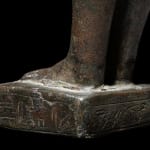Egyptian
An Egyptian bronze figure of Harpokrates, Late Period to Ptolemaic, circa 400 - 30 BC
Bronze
Height: 15.8 cm
Further images
The child Horus depicted nude and seated with his feet resting on a base. His right forefinger is pointed to his mouth, and he wears a cap with a uraeus...
The child Horus depicted nude and seated with his feet resting on a base. His right forefinger is pointed to his mouth, and he wears a cap with a uraeus and braided side lock of youth. The eyes are inlaid with silver and hieroglyphs are preserved on the base reading: '..sn son of Irt-Hor-irw, whose mother is Seshpet-Amen.
Provenance
Christie's, London, 16 December 1982, lot 177With Royal Athena Galleries, New York, 1985
Private collection, Germany
Literature
Harpokrates - a Hellenisation of the name ‘Heru-pa-khered' - depicted here in his guise of a young boy, representing Horus the child, son of Isis and Osiris. Harpocrates was regarded by the Egyptians as a deity of protection. Representations such as this show him as a nude boy with his finger to his mouth, and a sidelock of hair, the symbols of childhood. Misunderstanding the finger to mouth gesture (which is an imitation of the hieroglyph for child), the later Greeks and Roman poets made Harpokrates the god of silence and secrecy.Here he also has a uraeus (a cobra serpent) above his forehead, symbolising his entitlement to kingship as the son of Osiris. Once Roman rule came to Egypt the worship of Harpokrates spread throughout the empire, often as part of triad alongside the cults of Isis and Serapis. For a similar example see, The Cleveland Museum of Art, accession no. 1940.668.







